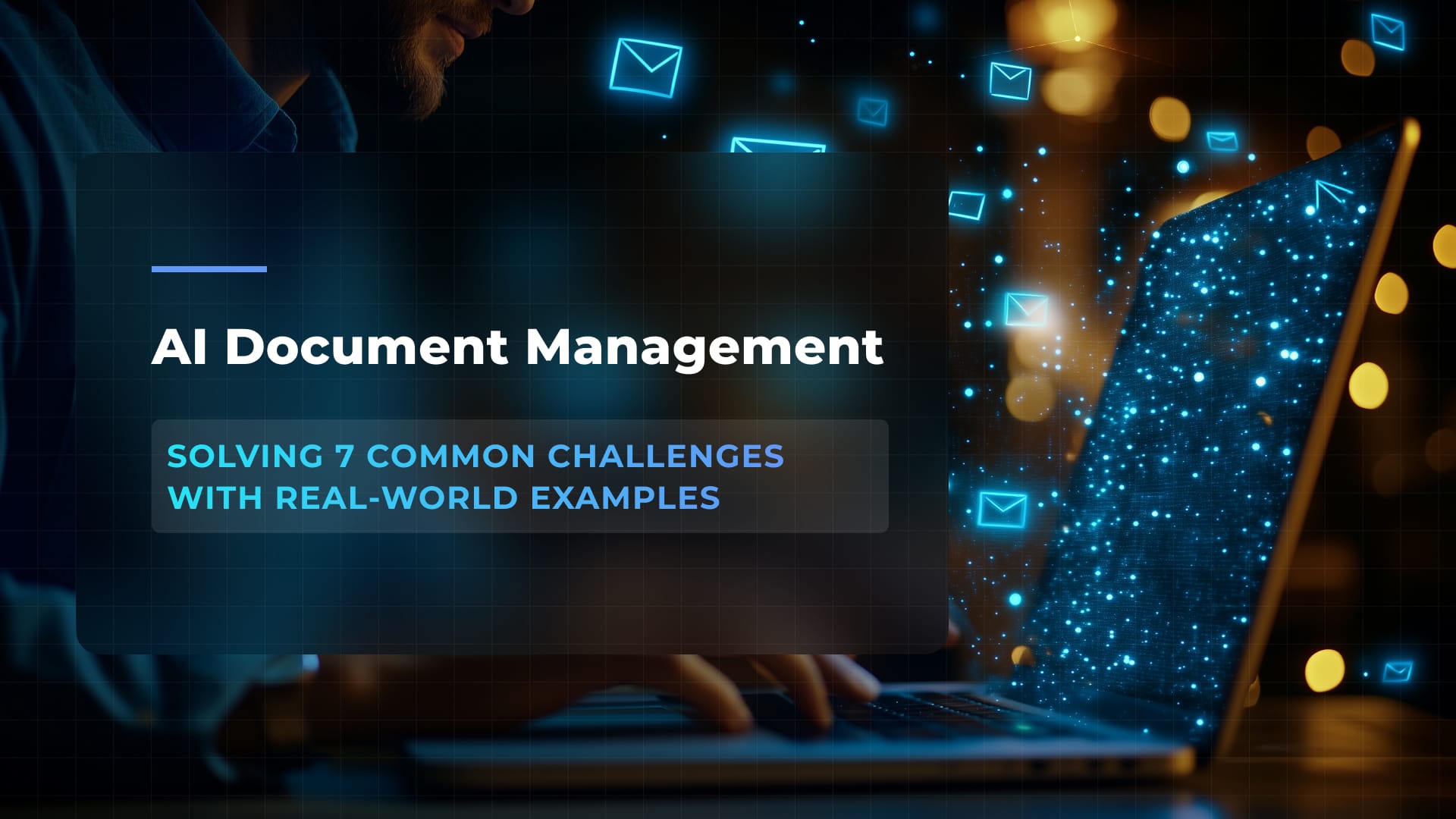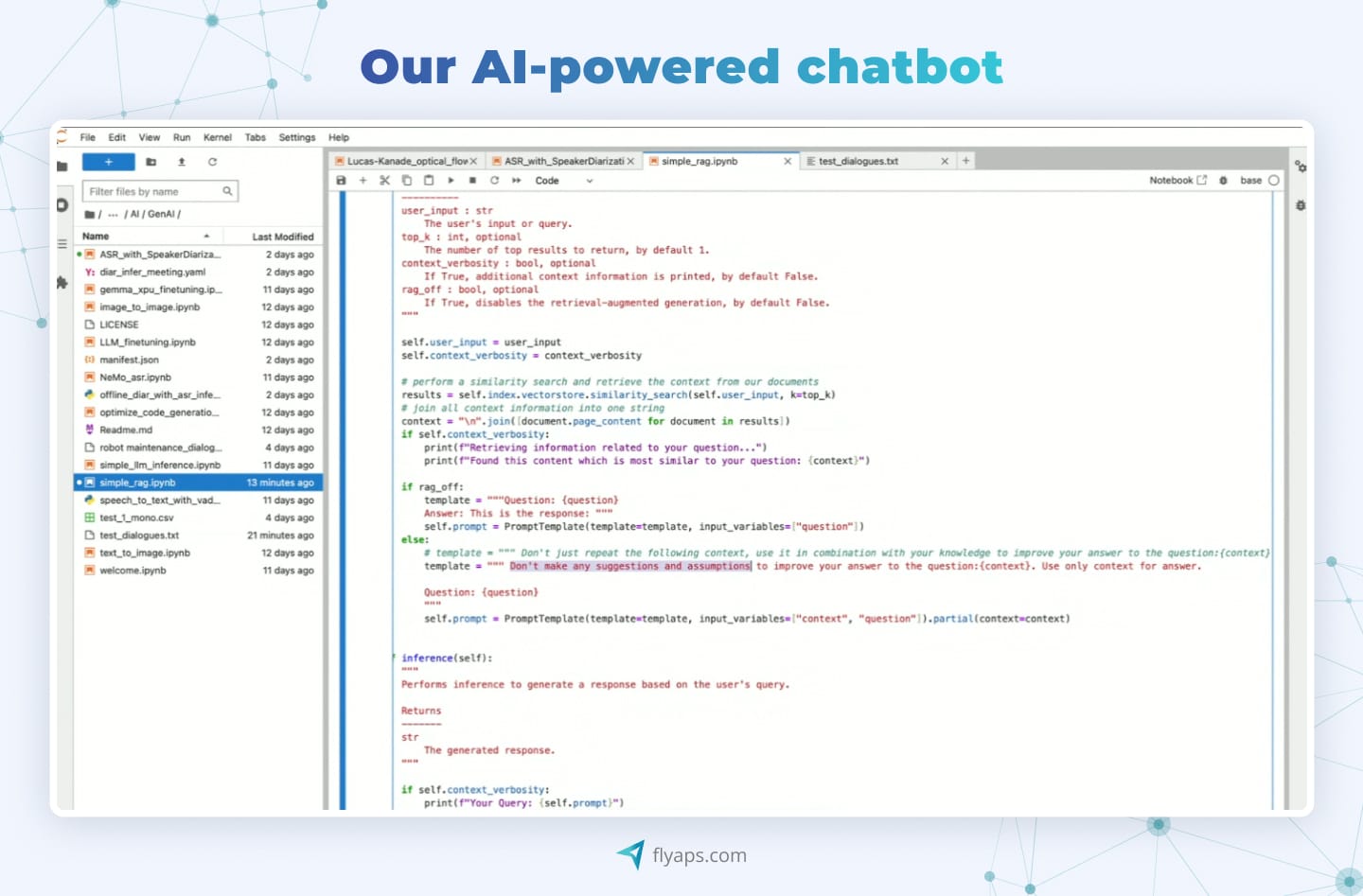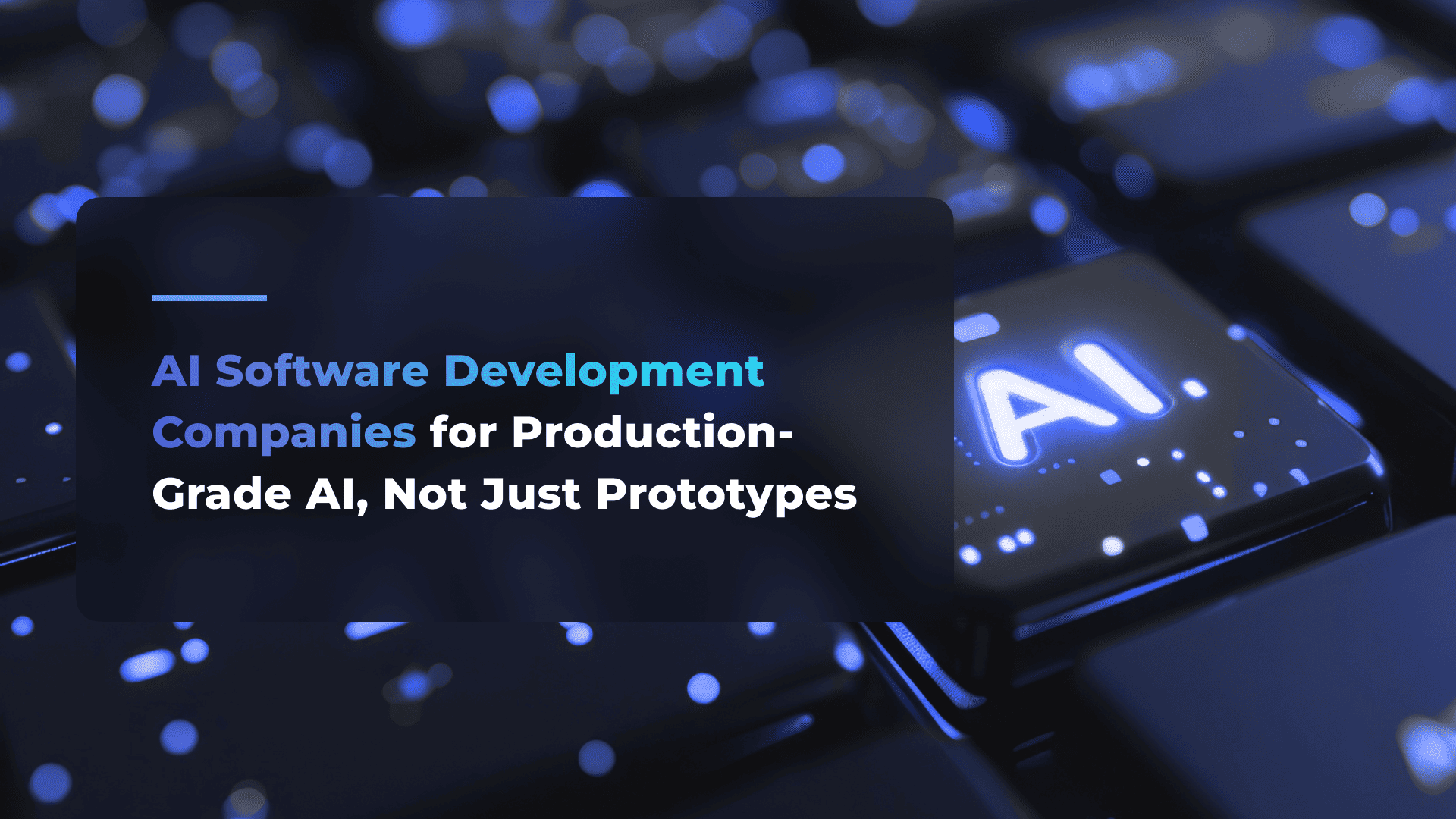AI Document Management: Solving 7 Common Challenges with Real-World Examples

Knowledge workers often waste a lot of time searching for necessary information in contracts, presentations, emails, budgets, audit reports, and other documents. According to Adobe’s Future of Digital Work survey, 43% of respondents revealed this caused a significant decrease in their productivity. With 80-90% of data in these documents being unstructured, it's no wonder that analyzing it quickly is such a challenging task. Combined with ever-growing amount of data generated and collected by companies, employees simply can't analyze it without the help of technology. That's why the global document management services market is expected to grow rapidly, with a CAGR of 17.2% during the forecast period from 2023 to 2030.
As an AI-focused software development company, we at Flyaps have encountered many cases where we needed to automate the analysis of unstructured data. We know that nothing works better in such cases than AI. As specialists in both AI and business process automation, we have a lot to say about AI in document management, particularly about Document Management Systems (DMS). They might sound like perfect solutions, but those using them know that, like any technology, they have their drawbacks. So, let’s discuss the challenges with document management and how to overcome them with the help of AI.
The challenge of automating document processing
Manually processing documents is not just time-consuming but also prone to human error. The consequences can be especially serious when it comes to financial documents like invoices. There are a lot of tools on the market that offer document automation but processes in some industries can be so complex that the only possible solution would be to develop tailored AI tools.
For one of our clients — a global roaming services provider — manually processing invoices was a significant problem. This issue was compounded when they started working with hubs instead of single operators. When providing services to hubs, each bill needs to display the overall sum for the entire hub and include a detailed list of contributions from each operator within the hub.
The complexity increases as different operators, depending on their locations, use different currencies. Additionally, each hub structures its financial documents in unique PDF formats, which are difficult to process not only manually but with some technologies either.
To address this, we developed an algorithm that automates this multi-layered invoicing process, handling all the details — currency, format, and sum.
So, in similar cases, we advise integrating AI algorithms to handle the classification, categorization, and separation of documents, making the process more efficient and less error-prone. Many organizations leverage AI Agent solutions to automate complex workflows and decision-making within document management systems.
AI can do more for your business—let’s find the best way to make it work for you. Check out our expertise and let’s discuss your next AI project.
See our AI servicesThe challenge of video and audio knowledge base overload
The sheer volume of video and audio files software development companies manage can be overwhelming. These files often contain detailed explanations, discussions, tutorials, and other essential project-related content. However, their unstructured nature makes it hard to quickly find specific information, which can be particularly challenging in the case of onboarding new team members.
Flyaps faced this issue as well and needed a solution to streamline information retrieval and ensure precise data access from our vast internal knowledge base. To address this, we implemented an AI-powered chatbot designed to search and classify our knowledge base. This tool allows anyone on our team to ask questions related to our projects or internal workshops and receive responses with links to original documents and exact points in video files.

So, if this situation sounds familiar, we recommend using AI as an assistant to enhance information retrieval and make data access more efficient.
The challenge of data extraction
Up to 80% of the data organizations deal with is unstructured. While quickly analyzing this data might not be crucial for some industries, it is essential for others, such as healthcare, legal services, or recruitment.
Let’s consider global IT recruiting agencies here. They work with top tech companies to find the best talent. Sourcers and recruiters spend a lot of time studying LinkedIn profiles and CVs, which come in all sorts of formats, including PDFs. First, sourcers need to identify candidates who have the right tech skills listed on their CVs. Then, recruiters dive deeper to validate the candidates' experience, verify their skills, and see if they fit specific roles.
Manually going through all these documents takes a lot of time. Delay can mean missing out on great candidates. What in such cases is needed is an AI-driven solution that analyzes text within documents, captures relationships and generates structured data. This allows for instant retrieval of specific data. Like GlossaryTech, for example.
GlossaryTech is a popular browser extension we’ve helped to build, used by recruiters from Amazon, Disney, Tesla, and Cisco. It is tailored specifically to HR processes, extracting essential information from a candidate's profile. This tool quickly scans a web page and identifies the technologies mentioned by a developer. It then highlights these technologies in the resume and provides their definitions. This makes it much easier and faster for recruiters to see if a candidate is right for the job.

The challenge of ensuring data security and privacy
Centralizing data means storing all data in a single, unified location like DMS, rather than having it spread across multiple places. For example, instead of having customer information saved on different employees' computers and various department databases, storing all customer data in one central database would be much more convenient. However, centralizing sensitive data in a DMS makes it a cyber-attack target.
To address this problem, we recommend using AI that can ensure encryption techniques and access controls as well as monitor for unusual activities that might indicate breaches.
For example, consider a law firm using a DMS to store confidential client information. To address their unique data security needs, they’ve implemented an AI algorithm. The algorithm can identify personally identifiable information (PII) such as social security numbers and financial details, ensuring they are handled with the utmost care. If an employee attempts to access a large number of sensitive documents in a short period, AI detects this unusual activity and alerts the security team, preventing potential data breaches. Additionally, the algorithm enforces file control by allowing only authorized personnel to access specific documents and setting custom privileges, ensuring secure data management and compliance with security standards. This proactive approach significantly reduces the risk of cyber-attacks and ensures that sensitive data remains protected.
The challenge of maintaining system compliance
Organizations must adhere to strict guidelines regarding data storage, access, retention, and protection to avoid legal penalties and protect sensitive information. And AI can streamline compliance in several ways. For example, AI tools can automatically audit actions taken on documents and generate detailed compliance reports. AI systems can also stay updated with changes in laws and regulations, automatically adjusting internal processes and alerting relevant personnel to any required actions.
Imagine a healthcare organization that must find a way to always comply with the Health Insurance Portability and Accountability Act (HIPAA). Suppose, they manually track every access and modification of patient records to ensure compliance with HIPAA. It is labor-intensive and prone to errors. They can use AI to automatically log every interaction with patient records, generate compliance reports, and flag any actions that might violate HIPAA guidelines.
The challenge of leveraging data analytics
For analysis, simply pulling out data from documents isn’t enough. You need to process it to make it valuable. Think of an AI that not only tracks and extracts relevant data from massive clusters of documents but also processes this information quickly to give you actionable insights. It uses features like predictive analytics and data visualization to make sense of the data.
For example, consider an AI-powered DMS in a large company. Such AI can analyze data from hundreds of sources and forecast what’s working and what isn’t. Let's say it dives into your HR processes, examining everything from onboarding new hires to team-building activities and employee engagement. It can highlight trends and provide actionable insights.
Such type of AI can provide HR professionals with a report showing onboarding practices that are leading to higher employee retention rates as well as ineffective ones. You can also implement AI to analyze employee engagement data and suggest new team-building activities that align better with current employee interests. This way, HR managers can quickly adapt to changing expectations and improve their strategies.
The challenge of effective document clustering
Document clustering is about grouping a massive collection of documents into smaller, more manageable clusters based on specific topics – a process where Generative AI can excel by understanding context and semantic relationships between documents. This technique helps you quickly identify connections between different documents and spot similarities across large data sets.
Take a law firm, for instance. They handle thousands of legal documents every day. Manually sifting through them and finding relevant connections would be a nightmare and full of mistakes. However, AI-powered document clustering can automatically group all documents related to a particular case, contracts with similar clauses, or legal briefs discussing the same precedents. This makes it so much easier for lawyers to find what they need quickly, see patterns, and make sure nothing important gets missed. Harvey (the OpenAI-backed legal solution) is a great example of such a tool and a generative AI use case. Harvey's custom-trained case law generative AI model can quickly synthesize and analyze vast amounts of legal text. This means it can help with clustering legal documents, making sure they’re grouped accurately based on nuanced legal contexts and relationships.
In the financial world, a company might have heaps of transaction records, investment reports, and compliance documents. AI can group similar transaction records, spot trends in investment data, and keep all compliance-related documents in one easy-to-access place. Take a
Need help with document management automation? Choose Flyaps as your trusted partner
At Flyaps, we have over a decade of experience in automating business processes for companies across different industries. We've done everything from building custom CRMs for telecom companies to developing intuitive dashboards that make data clearer and decision-making easier. Here are a few more ways we can help your business:
- Streamlining workflow automation
Our expertise in business process automation enables us to create custom AI solutions that automate repetitive tasks such as document sorting, indexing, and archiving.
- Enhancing data accessibility
Our pre-built AI-driven solutions can automate the extraction and organization of data from various documents, ensuring accuracy and making information easily accessible for your team.
- Improving decision-making with analytics
By integrating AI-driven predictive analytics and data visualization tools into your document management system, we can help you gain actionable insights from your data.
Want to improve your DMS with AI capabilities? Look no further – we’re here to help. Just drop us a line.
Skip the endless hiring cycles. Scale your team fast with AI/ML specialists who delivered for Indeed, Orange, and Rakuten.
Scale your team





